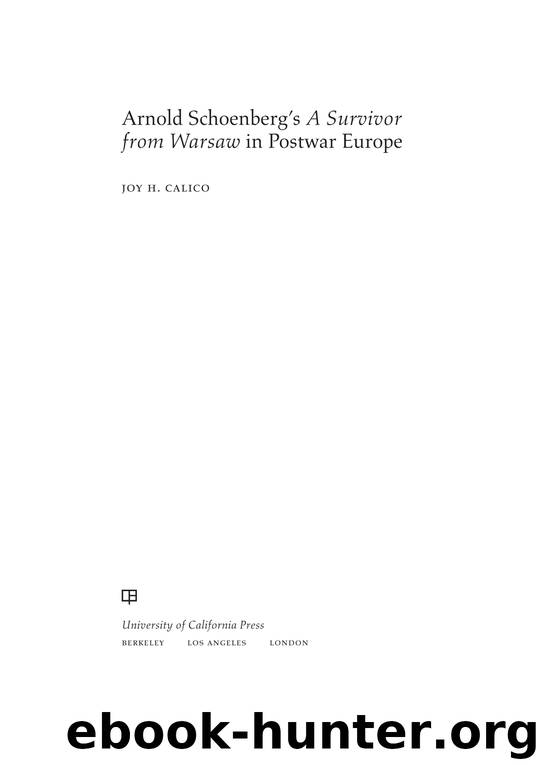Arnold Schoenberg's A Survivor from Warsaw in Postwar Europe by Calico Joy H

Author:Calico, Joy H.
Language: eng
Format: epub
ISBN: 9780520281868
Publisher: University of California Press
MUSICAL STYLE AS CULTURAL DIPLOMACY
Despite the paper trail documenting this labyrinthine process, the precise point at which the East Germans settled on the concert repertoire and who did so is not known, although pragmatism surely played a role in that decision. Given just three weeks’ notice, all the music had to come from repertoire the Leipzig ensemble already knew, and that group had probably been chosen in the first place because it had a reputation for performing new music; Kegel had a particularly close relationship with Dessau and premiered many of his works. The LRSO and Choir first entered the conversation when the RSK recommended them back on 25 February, by which time that committee had known for a month that Kegel’s group was scheduled to perform and record A Survivor that April in Leipzig.55 The short lead time also posed a challenge for the MfAA, which needed to inoculate members of the ensemble against the political liberalization they would encounter in the PRP and ensure their political reliability. A political staff was dispatched to Leipzig to brief them, and the tour was accompanied by a party of five from the political leadership whose job was to make sure everyone toed the party line.56
The program the East Germans brought to Warsaw Autumn was calculated to perform cultural diplomacy primarily for the Poles (who needed their “help”) as well as for an international audience from both sides of the Cold War divide. The concert showcased two works by East German composers (important since there had been no music or performers from the GDR in the first festival) and a third by a composer representative of the theme of that year’s festival: the Second Viennese School.57 All three pieces had been written in the last ten years. The concert began with Symphony no. 4 for String Orchestra (1958) by Johann Cilenšek (1913–98) and A Survivor, which was encored due to audience demand; the second half was given over to Die Erziehung der Hirse (The Cultivation of the Millet, 1952–54) by Dessau. Cilenšek’s string symphony was a diatonic piece for conventional forces in familiar form; A Survivor was, from the East German perspective, an acceptable use of dodecaphony because it served an antifascist political message; and Dessau’s piece was a “musical epic” for narrator, solo voice, mixed choir, and large orchestra with a text by Brecht, the GDR’s favorite playwright and poet, recently deceased. Dessau had bona fide credentials as a modernist: The opera he wrote with Brecht in 1951 entitled Die Verurteilung des Lukullus had occasioned the first big cultural-political firestorm in the GDR, but by all accounts Die Erziehung did not rise to that standard. It is a declamatory, syllabic setting of a ballad “in praise of a nomad hero of Kazakhstan who turns to the cultivation of millet and manages to grow enough to support the Red Army against Hitler.”58 It is also fifty-two verses long.
Understanding the Polish reaction to this gesture of East German cultural diplomacy requires some knowledge of Warsaw Autumn.
Download
This site does not store any files on its server. We only index and link to content provided by other sites. Please contact the content providers to delete copyright contents if any and email us, we'll remove relevant links or contents immediately.
The Cello Suites by Eric Siblin(916)
Hungarian by Hungarian(731)
Bach's Musical Universe by Christoph Wolff(659)
Franz Liszt by Saffle Michael(563)
Secret Lives of Great Composers by Elizabeth Lunday(546)
Stravinsky by Stephen Walsh(522)
Curious and Modern Inventions: Instrumental Music as Discovery in Galileo's Italy by Rebecca Cypess(518)
Music for Silenced Voices by Wendy Lesser(481)
The Complete Idiot's Guide to Classical Music by Sherman Robert(480)
Music In The Baroque Era - From Monteverdi To Bach by Manfred F. Bukofzer(466)
The Cambridge Companion to Stravinsky by Jonathan Cross(464)
The Beethoven Syndrome by Mark Evan Bonds(464)
The Romantic World of Puccini: A New Critical Appraisal of the Operas by Iris J. Arnesen(459)
Music for Life: 100 Works to Carry You Through by Fiona Maddocks(457)
Chopin's Piano by Paul Kildea(436)
Rachmaninoff's Complete Songs by Richard D. Sylvester(434)
The Detroit Symphony Orchestra by Harris Laurie Lanzen; Ganson Paul;(423)
Guide to Sonatas: Music for One or Two Instruments by Melvin Berger(416)
Dangerous Melodies by Jonathan Rosenberg(400)
